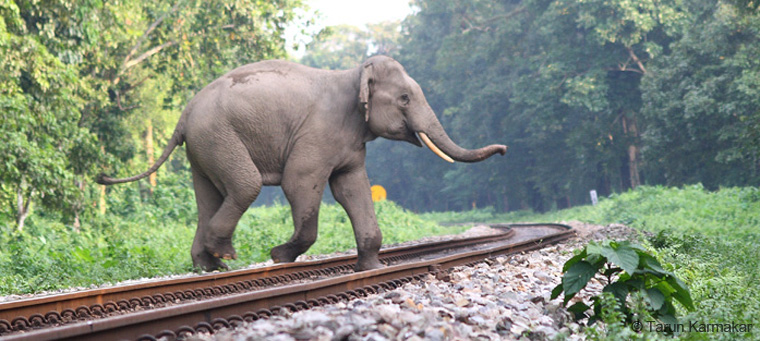Tracks should have been built on pillars.
That is a solution, unfortunately it adds hugely to the cost. A more cost effective solution here is to do survey and find points on tracks where elephants pass cross the tracks. It is an established fact that Elephants move in hordes and have fixed pattern of movement (both in terms of time and location). So what Railways does is use methods like patrolling of these sectors, use of rail side warning signs for drivers and avoiding night time trains and above all clamp speed limits.
here is a nice story on how these efforts are being put to reduce unfortunate casualties.
--------------------------------------------------------------------------------------------------------------------------------
With the growth of India’s economy, high-speed railways are increasingly cutting through prime elephant habitat, with fatal consequences: in the past ten years more than 100 elephants have been struck and killed by trains in India, and the toll keeps rising. 2010 was the worst on record, with at least 24 deaths recorded, while a spate of four collisions with trains claimed 16 elephant lives between 30th December 2012 and 4th February 2013, drawing renewed attention to this growing menace. Without preventive measures to protect elephants, their death toll will rise much further.

Fortunately, simple, but effective measures can be taken to significantly reduce the threat of trains striking elephants. These include the introduction of “go-slow” zones and warning signs in accident hotspots, the clearance of shrubbery around blind spots, workshops for train drivers, and running night patrols to alert drivers to elephants in the area. These were first introduced in 2002 in Rajaji National Park, Uttarakhand State, through a pioneering project led by the
Wildlife Trust of India, which eliminated elephant deaths for the next ten years. And so we’ve been working with them since 2008 to replicate this success.
Aim:
To significantly reduce the number of elephants killed by trains throughout India
Results:
After Uttarakhand, the next state to receive attention was Assam, but unlike the contained space of Rajaji National Park, the problem in Assam is spread over a vast area, with sites up to 700km apart, nine important habitat areas and 26 critical railway sections. We have therefore had to focus our attention on key areas and develop intervention measures that are site-specific. In order to do so much time has been invested researching issues related to elephant movement, critical track sections, surrounding habitat, and other contributing factors to accidents. Having been working there since 2009, the Elephant Family-WTI field team now has a thorough understanding of where, when and why elephants cross the rail tracks.
The following have all been carried out in Assam: the installation of 54 warning signs for train drivers, clearance of vegetation along the tracks, the strategic placing of posters on the issue in all priority areas to serve as a constant reminder to railway staff, and workshops for train drivers and other railway staff. Patrols along the tracks at night have continued to be one of the most effective measures for preventing accidents. Equipped with uniforms, reflective jackets, high-powered torches, raincoats and whistles etc, the patrol teams monitor the movement of elephants to drive them on when crossing the tracks and to alert any oncoming trains to bring them to a stop, thereby averting any potential accidents. Across six critical locations in Assam as many as 329 potential collisions between trains and elephants were averted in 2011, and a further 228 in 2012.
In India’s southern states of Kerala and Tamil Nadu, surveys of the tracks were carried out in 2010, and effective implementation of similar measures began in 2011. Night patrols along the tracks got underway in June 2011 on one of particularly critical stretch where a
young female elephant was killed in August 2010. These patrols are using colour-coded lights to alert oncoming train drivers to the presence of elephants, and by the end of the year five accidents had been prevented on this stretch. Unlike Assam, this southern region does not suffer from insurgencies, and the colour-coded lights can be used without presenting a security risk.
In another departure from the measures used in Assam and elsewhere, three tree huts have been constructed along the tracks to help in monitoring elephant movement, particularly during the rainy season. Posters have been placed in key locations and public announcements have been made at railway stations to draw railway staff and the public’s attention to the issue. Twenty-two warning signs are being installed to alert train drivers to accident hotspots. Workshops have been held with train drivers, guards and stationmasters to introduce them to the required measures, and coordination meetings are held regularly with railway and forest officials.
Elephant Family was grateful to receive significant support from the
Nando Peretti Foundation towards this project.
http://elephant-family.org/saving-elephants-on-indias-railways
----------------------------------------------------------------------------------------------------------------------------------------------------------












